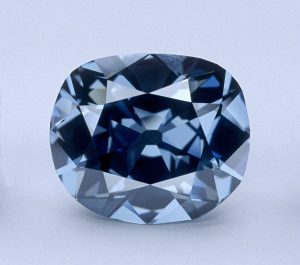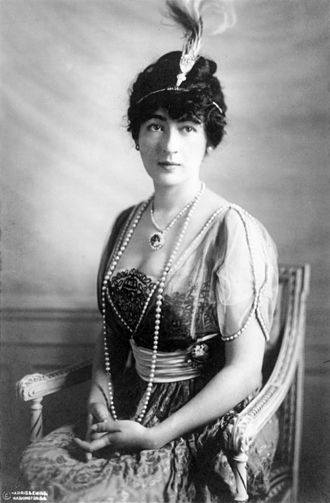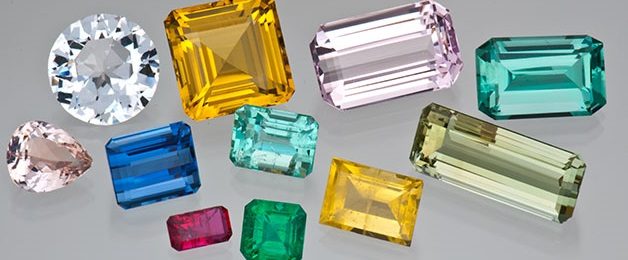The Hope Diamond is one of the most famous gemstones in the world. Currently residing in the Smithsonian Institution, in Washinton DC, the deep blue Hope Diamond weighs in at 45.52 carats and is graded as VS1. It is 21.78 mm wide, 25.60 mm long and 12.00 mm deep.
The gemstone has long been rumoured to carry a curse, possibly due to agents trying to arouse interest. It was last reported to be insured for $250 million.
Beauty in Science – The strange red glow that emits from the diamond helps scientists “fingerprint” blue diamonds, allowing them to “tell the real ones from the artificial.”
The stone exhibits an unusually intense and strongly colored type of luminescence: after exposure to short-wave ultraviolet light, the diamond produces a brilliant red phosphorescence (‘glow-in-the-dark’ effect) that persists for some time after the light source has been switched off, and this strange quality may have helped fuel “its reputation of being cursed.” The red glow helps scientists “fingerprint” blue diamonds, allowing them to “tell the real ones from the artificial.” The red glow indicates that a different mix of boron and nitrogen is within the stone, according to Jeffrey Post in the journal Geology.
People typically think of the Hope Diamond as a historic gem, but this study underscores its importance as a rare scientific specimen that can provide vital insights into our knowledge of diamonds and how they are formed in the earth.

The Royal Family Jewels have quite a story to tell…
Although, no one is entirely sure who discovered the Hope Diamond originally, the history which includes the source of the name, began when French merchant traveller, Jean Baptiste Tavernier, purchased a 112 3/16-carat diamond. This diamond, which was most likely from the Kollur mine in Golconda, India, was somewhat triangular in shape and crudely cut. Its colour was described by Tavernier as a “beautiful violet.”
Tavernier sold the diamond to King Louis XIV of France aka the Sun King, in 1668 along with 14 other large diamonds and several smaller ones.
In 1673 the stone was recut by Sieur Pitau, the court jeweller, resulting in a 67 1/8-carat stone. The royal inventories described its colour as an intense steely-blue and the stone became known as the “Blue Diamond of the Crown,” or the “French Blue.” It was set in gold and suspended on a neck ribbon which the king wore on ceremonial occasions.
King Louis XIV, in 1749, had the stone reset by court jeweller Andre Jacquemin, in a piece of ceremonial jewellery for the Order of the Golden Fleece (Toison d’Or).
Some chapters later, in the tumultuous history of France and its royals, the stone was again a protagonist. After the 1791 attempt by Louis XVI and Marie Antoinette to flee France, the jewels of the French Royal Treasury were turned over to the government. During a week-long looting of the crown jewels in September of 1792, the French Blue diamond was stolen.
In 1812 a deep blue diamond described by John Francillon as weighing 177 grains (4 grains = 1 carat) was documented as being in the possession of London diamond merchant, Daniel Eliason. In September 1812 Francillon was allowed to trace around an unset 45.5-carat (9.10 g) blue cushion-shaped diamond in the possession of the diamond merchant Daniel Eliason. Francillon drew the diamond in plan and elevation, colouring the plan drawing to match the deep blue colour of the stone. Below the drawings, he wrote notes to explain that he had been given permission to draw the gem by its owner, Eliason and that it was ” … a very curious superfine deep blue Diamond.” – Wikipedia
Strong evidence indicates that the stone was the recut French Blue and the same stone known today as the Hope Diamond. Several references suggest that it was acquired by King George IV, the grandson of King Louis XVI. In 1830, upon his death, King George IV, debts were so enormous that the blue diamond was likely sold through private channels.
The first reference to the diamond’s next owner is found in the 1839 entry of the gem collection catalogue of the well-known banker Henry Philip Hope, the man from whom the diamond takes its name. Unfortunately, the catalogue does not reveal where or from whom Hope acquired the diamond or how much he paid for it.
Following the death of Henry Philip Hope in 1839, and after much litigation, the diamond passed to his nephew Henry Thomas Hope and ultimately to the nephew’s grandson Lord Francis Hope. In 1901 Lord Francis Hope obtained permission from the Court of Chancery and his sisters to sell the stone to help pay off his debts. It was sold to a London dealer who quickly sold it to Joseph Frankels and Sons of New York City, who retained the stone in New York until they, in turn, needed cash. The diamond was next sold to Selim Habib who put it up for auction in Paris in 1909. It did not sell at the auction but was sold soon after to C.H. Rosenau and then resold to Pierre Cartier that same year. Cartier became the owner and on January 28, 1911, sold it to Edward B. McLean. In a deal concluded in the offices of the McLean family’s Washington Post newspaper, Pierre Cartier sold the diamond for $180,000. A clause in the sale agreement for the diamond stated that the stone was widely believed to bring death and disaster to its owner- “Should any fatality occur to the family of Edward B. McLean within six months, the said Hope diamond is agreed to be exchanged for jewellery of equal value”. By March, the diamond had not been paid for in accordance with the terms of the sale agreement. Cartier hired a lawyer to sue McLean for payment who responded by saying it was on a loan for inspection. On February 2, 1912, the New York Times reported that the “Wealthy Purchasers of Famous Stone to Retain It Despite Sinister Reputation. “

Mrs Evalyn Walsh-McLean-Wikipedia
In 1910 the Hope diamond was shown to Mrs Evalyn Walsh McLean, of Washington D.C., at Cartier’s in Paris, but she did not like the setting. Cartier had the diamond reset and took it to the U.S. where he left it with Mrs McLean for a weekend. This strategy was successful. The sale was made in 1911 with the diamond mounted as a headpiece on a three-tiered circlet of large white diamonds. Sometime later it became the pendant on a diamond necklace as we know it today. Mrs McLean’s flamboyant ownership of the stone lasted until her death in 1947.
Harry Winston Inc. of New York City purchased Mrs McLean’s entire jewellery collection, including the Hope diamond, from her estate in 1949. This collection also included the 94.8-carat Star of the East diamond, the 15-carat Star of the South diamond, a 9-carat green diamond, and a 31-carat diamond which is now called the McLean diamond.
For the next 10 years, the Hope diamond was ‘on tour’ being displayed at many exhibits and charitable events world wide by Harry Winston Inc., including as the central attraction of their Court of Jewels exhibition. On November 10, 1958, they donated the Hope diamond to the Smithsonian Institution, and almost immediately the great blue stone became its premier attraction.
references:






